1. Yogic Alphabet
Asanas make you strong and healthy and eradicate many diseases.
Bhastrika Pranayama develops lungs, destroys the germs of tuberculosis, augments lung-power and lung-capacity.
Constipation is removed by the practice of Bhujanga, Salabha and Dhanur Asanas.
Dhanurasana is a combination of Bhujanga and Salabha Asanas.
Eating in moderation, plain living and high thinking help the Yogic student in attaining his goal quickly.
Fasting eliminates poison, purifies the system and invigorates the cells.
Garbhasana augments the digestive power, increases the appetite and removes many intestinal diseases.
Halasana makes the spine very supple and elastic.
Indriyas should be controlled by the practice of Pratyahara.
Japa of ‘Om’ or ‘Hari Om’ should go hand in hand with Asanas and Pranayamas.
Kumbhaka helps to attain longevity and awakens the Kundalini.
Lolasana strengthens the muscles of the arms and forearms.
Mind can be controlled by Vairagya, Abhyasa, Satsanga Vichara, eradication of Vasanas, destruction of egoism, Pranayama, meditation, and cultivation of virtues, such as mercy, complacency, self-denial, Santi and Santosha.
Nadi Suddhi can be obtained by the practice of Pranayama.
Oordhva Padmasana checks wet-dreams and transmutes the sexual energy into Ojas.
Paschimottanasana removes fat, increases the gastric fire and eradicates diseases of the stomach.
Quetta earthquake is nothing when compared to the agitation caused in the mind by the turbulent senses.
Regularity in the practice of Asana and Pranayama is indispensably requisite for quick and solid progress.
Sirshasana is the king of all Asanas. It transmutes seminal energy into Ojas, develops memory and intellectual capacity, and removes a host of ailments.
Trataka helps concentration of the mind and removes diseases of the eyes.
Uddiyana Bandha imparts beautiful health, strength, vigour and vitality and removes the disorders of the alimentary system.
Vajrasana removes drowsiness, strengthens the spine, helps digestion and is very useful for meditation.
Winter is the best time for rigorous practice of Yoga.
Xerostomia (abnormal dryness of the mouth) can be removed by the practice of Sitali and Sitkari Pranayamas.
Yoga Mudra removes the disorders of the abdomen and awakens Kundalini.
Zerosis is the disease of the eye owing to the deficiency of Vitamin ‘A’. This is removed by the practice of mild Trataka and Sirshasana.

2. Padmasana
You must be able to sit in an Asana quite steady at a stretch for full three hours. Then only you will get mastery over the Asana (Asana Jaya). Without securing a steady Asana you cannot get on well in meditation. The more steady you are in your Asana, the more you will be able to concentrate and make your mind one-pointed. If you can be steady in the posture even for one hour, you will be able to acquire one-pointed mind and feel thereby infinite Peace and Atmic Bliss inside. Four Asanas, viz., Padmasana, Siddhasana, Svastikasana and Sukhasana, are prescribed for meditative purposes. Rishis like Gheranda, Sandilya and others speak very highly of Padmasana. This is highly agreeable to householders.
Spread a seat on the ground and take your seat facing North or East. Spread the legs forward. Take hold of your right foot and keep it on the left thigh and then place the left foot over the right thigh. Place the hands on the knees. You can make a finger-lock and keep the hands over the left ankle. Sit erect, keeping the back, neck and head in one straight line. Close your eyes and begin your Japa and meditation.
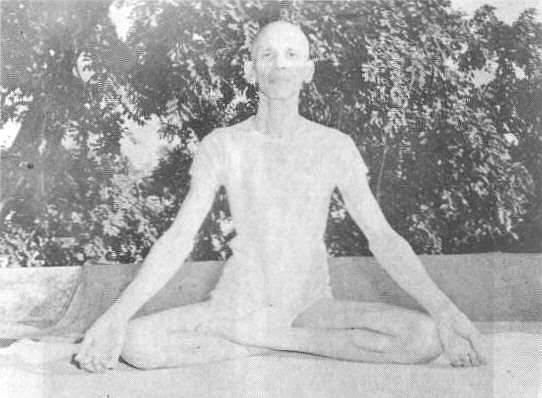
3. Siddhasana
Next to Padmasana comes Siddhasana in importance. Young Brahmacharins who attempt to get established in celibacy should practice this Asana. Sit on your seat. Spread the legs. Take hold of your left foot and keep the heel at the anus and then place the right heel at the top of the generative organ. Hands can be placed as in Padmasana.
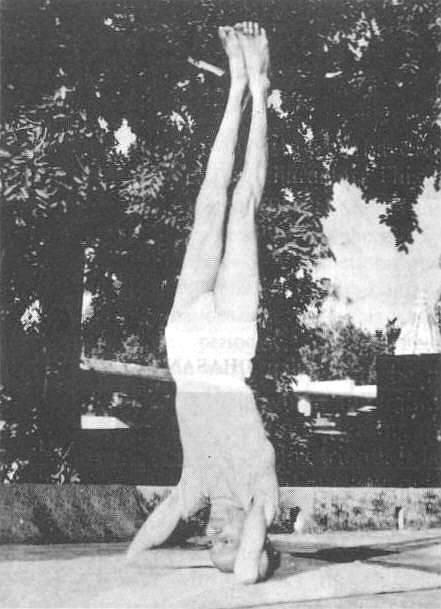
4. Sirshasana
Sirshasana, Sarvangasana and other exercises are intended for general health, for an all-round development of the body and for maintaining Brahmacharya. Sirshasana is king of all Asanas. The seminal energy is transmuted into Ojas-sakti. In this Asana alone the brain can draw plenty of Prana and blood. Great benefit is derived by sitting for meditation after the practice of Sirshasana. All diseases of the eyes, nose, head, throat, stomach and other organs are removed. The advantages that are derived from this Asana are incalculable. This is a powerful blood-purifier and nervine tonic. Memory-power improves admirably.
Spread a four-folded blanket. Sit on two knees. Make a finger-lock by interweaving the fingers. Place it on the ground. Now keep the top of your head on the ground between the finger-lock and raise your legs slowly till they become vertical. Avoid jerks. Learn this Asana by the side of a wall and get the help of your friend, till you learn balancing.
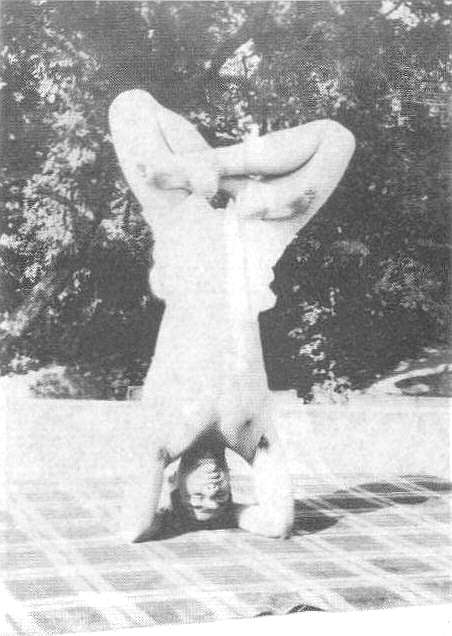
5. Oordhva-Padmasana
Perform-Sirshasana. Slowly bend the right leg and keep it on the left thigh and then the left leg on the right thigh, forming a foot-lock as in Padmasana. Do this slowly and avoid jerks or a fall. When you know the balancing in Sirshasana perfectly, you can attempt for this Asana. This Asana helps the practitioner to maintain Brahmacharya. All other benefits of Sirshasana are derived by the practice of this Asana.
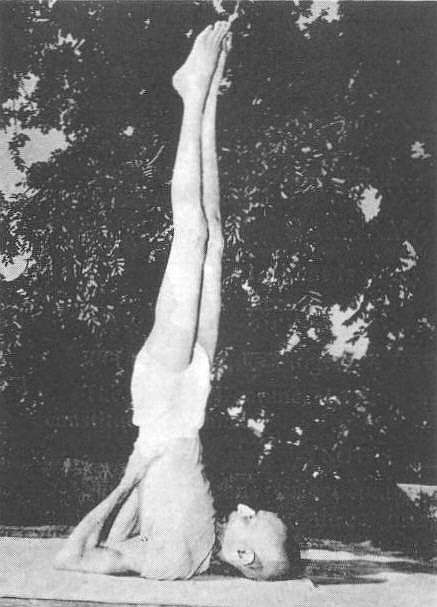
6. Sarvangasana
Spread a blanket on the floor and lie on the back quite flat. Slowly raise the legs, hips and trunk. Support the back with the two hands and rest the elbows on the ground. Press the chin against the chest. Remain in the Asana for 5 seconds and slowly bring the legs to the ground. Gradually you can increase the period to 20 minutes. This Asana gives wonderful benefits. It keeps the spine elastic and helps you to maintain Brahmacharya. Elasticity of spine means everlasting youth. After performing this Asana, do Matsyasana. You can derive the maximum benefit of Sarvangasana.
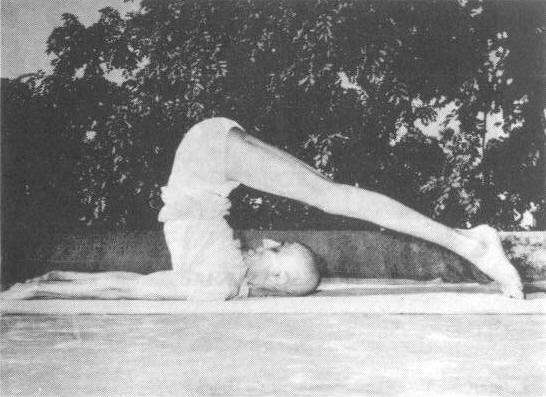
7. Halasana
Spread a blanket on the ground and lie flat on your back. Keep the hands at the sides on the ground with the palm facing the ground. Join both your legs. Lift the legs slowly up as in Sarvangasana. Do not bend the legs. Do not raise the hands. Then slowly lower the legs until the toes touch the ground above the head. Keep the knees close. Remain in the Asana for 5 seconds and increase the period to 5 minutes by gradual practice. Then raise the legs slowly and come back to the original position.
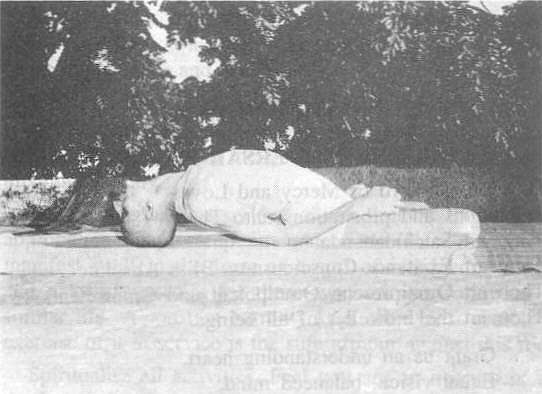
8. Matsyasana
Sit on the blanket and form the foot-lock as in Padmasana. Then lie flat on the back. Stretch the head back so that the top of your head rests on the ground firmly on one side and the buttocks on the other, thus making a bridge or an arch of the trunk. Place the hands on the thighs or catch hold of the toes. Remain in this Asana for 3 seconds or half the period that you devote to Sarvangasana. This Asana must be done immediately after performing Sarvangasana. This Asana destroys many diseases and removes constipation.
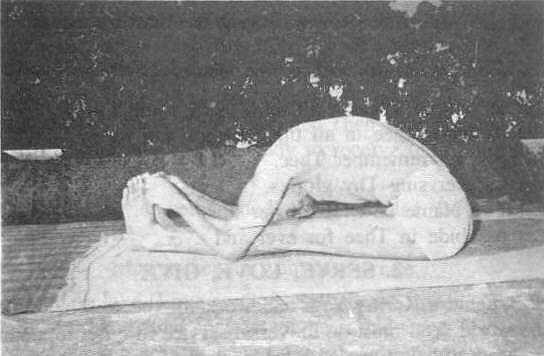
9. Paschimottanasana
Sit on the ground and stretch the legs stiff like a stick. Catch the toes with the thumb, index and middle fingers. While catching, you will have to bend the trunk forwards. Exhale. Slowly bend without jerks till your forehead touches your knees. You can keep the face between the knees also. You can bend the hands and rest the elbows on the ground. Retain the pose for 5 seconds and gradually increase to 5 minutes. This is an excellent Asana. This Asana relieves constipation, removes sluggishness of liver, dyspepsia and gastritis. Muscles and organs of the abdominal viscera are toned up completely.

Great Post especially the technical words that have been explained in the post is of great use for the general public.
ReplyDeletehit training